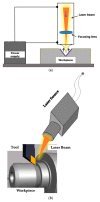Laser-Based Manufacturing of Ceramics: A Review
- PMID: 37630099
- PMCID: PMC10456894
- DOI: 10.3390/mi14081564
Laser-Based Manufacturing of Ceramics: A Review
Abstract
Ceramics are widely used in microelectronics, semiconductor manufacturing, medical devices, aerospace, and aviation, cutting tools, precision optics, MEMS and NEMS devices, insulating components, and ceramic molds. But the fabrication and machining of the ceramic-based materials by conventional processes are always difficult due to their higher hardness and mechanical properties. Therefore, advanced manufacturing techniques are being preferred for these advanced materials, and out of that, laser-based processes are widely used. The benefits of laser fabrication and machining of ceramics include high precision, reduced thermal damage, non-contact processing, and the ability to work with complex geometries. Laser technology continues to advance, enabling even more intricate and diverse applications for ceramics in a wide range of industries. This paper explains various laser based ceramic processing techniques, such as selective laser sintering and melting, and laser machining techniques, such as laser drilling, etc. Identifying and optimizing the process parameters that influence the output quality of laser processed parts is the key technique to improving the quality, which is also focused on in this paper. It aims to facilitate the researchers by providing knowledge on laser-based manufacturing of ceramics and their composites to establish the field further.
Keywords: MMC; ceramic; composite; laser; machining; sintering.
Conflict of interest statement
The authors declare no conflict of interest.
Figures
References
-
- Miloš M., Marin G., Dragan R., Miroslav R. Coteaţă Margareta Mathematical Modelling Of The CO2 Laser Cutting Process Using Genetic Programming. Facta Univ. Ser. Mech. Eng. (FU Mech. Eng.) 2022;20:665–676.
-
- Madić M., Kovačević M., Radovanović M., Blagojević V. Software Tool For The Laser Cutting Process Control—Solving Real Industrial Case Studies. Facta Univ. Ser. Mech. Eng. 2016;14:135–145. doi: 10.22190/FUME1602135M. - DOI
-
- Liu C., Sun J., Li G., Li B., Gong F. Fabrication, mechanical properties and fracture behaviors of the laminated Al2O3–ZrB2–MgO/Al2O3–TiN–MgO ceramic composite. Ceram. Int. 2020;46:857–865. doi: 10.1016/j.ceramint.2019.09.043. - DOI
-
- Deckard C.R. Method and Apparatus for Producing Parts by Selective. US4863538A. Sintering. Patent. 1989 September 5;
Publication types
LinkOut - more resources
Full Text Sources




